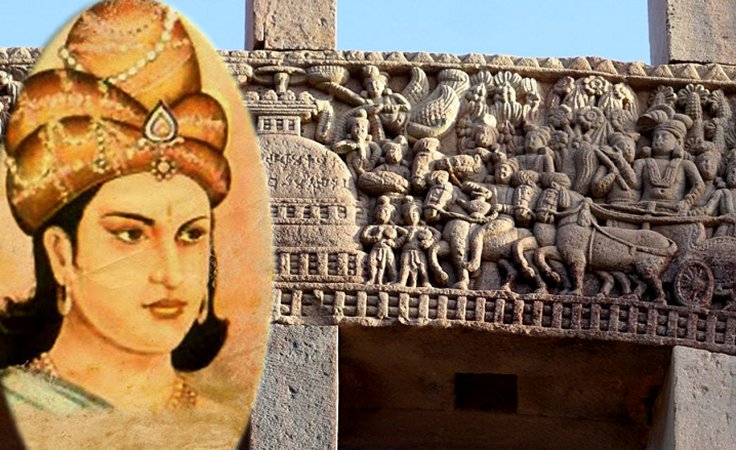Ellen Lloyd – AncientPages.com – The history of Emperor Ashoka shows it’s never too late to change and become a good person.
Emperor Ashoka was a remarkable person and ruler whose legacy is still alive and tangible in modern India. Paper money and coins can be traced to Emperor Ashoka’s reign and the same can be said about several ancient symbols that are today used in India.

Left: Emperor Ashoka. Credit: Public Domain – Right: King Ashoka visits Ramagrama, to take relics of the Buddha from the Nagas, but in vain. Southern gateway, Stupa 1, Sanchi. Credit: PH๏τo Dharma – CC BY 2.0
It’s unknown when exactly Ashoka was born, but he lived in the 3rd century B.C, and he became the third monarch of the Mauryan dynasty. He ruled over a vast empire from 268 to 232 B.C.
Ashoka Was The Grandson Of Legendary Ruler Chandragupta
In some ways, it seems he was destined to become a great emperor, and he is nowadays remembered as one of the most exemplary rulers in world history. As the son of Bindusara, grandson of Chandragupta, Ashoka certainly lived up to his family’s reputation as an effective Emperor.
His grandfather, Chandragupta was so inspired by the conquests of Alexander the Great that he created the kingdom of Magadha, the first and largest empire of ancient India. The kingdom of Magadha was so huge it covered almost the entire Indian Peninsula.
Chandragupta was an outstanding monarch and he was even admired by the Greeks, but like most rulers, he often feared for his life. He was afraid of being ᴀssᴀssinated and eventually, he abandoned the throne and became a Jain monk. Chandragupta started practicing Sallekhana, which was a clear sign he wanted to depart from this world. Sallekhana is a controversial religious practice in which a Jain stops eating with the intention of preparing for death. It took years, but he did starve himself to death by fasting.
When Ashoka ascended the throne around 268 B.C., many regarded him a cruel ruler, but he was different and had a unique approach when addressing his subordinates.

One of the major rock edicts with an inscription made by Emperor Ashoka. Credit: Muhammad Zahir, CC BY-SA 3.0
It was first in the 19th Century that historians could piece together the history of Ashoka, and it’s possible he did accomplish more than scholars currently know. With the discovery of Buddhist texts, carved inscriptions, and proclamations, historians learned that Emperor Ashoka was a supporter and patron of Buddhism. It was during his reign that Buddhism spread east and west to other parts of the ancient world.
It seems somewhat contradictory that a mighty ruler who conquered new lands could be such a peaceful man. Emperor Ashoka was intended on expanding his borders of power and his conquests were successful, reaching the territories of today’s Iran and Afghanistan. Still, as history has shown on so many occasions, conquering new lands means killing people, and death was not something Emperor Ashoka could avoid.
How The Kalinga War Changed Emperor Ashoka
Though he managed to improve communication conditions on an important trade route connecting Syria with Central Asia, there was one particular battle that changed his life forever.
The turning point was the sight he could stand during his conquest of Kalinga, the state of the Dravidians in the south of the subcontinent.
Emperor Ashoka won the Kalinga War, a battle fought between him and the Mauryan army led by King of Raja Anantha, but the price was high. The war took a tremendous toll on life and property. More than 100,000 soldiers were killed, and 150,000 civilians were deported. Hundreds of thousands of animals were also killed.
All these deaths and suffering made him realize life for all living beings must be improved and respected. Emperor Ashoka changed completely. From being a bloodthirsty ruler, he converted to Buddhism and became a more peaceful emperor.
The last words of Emperor Ashoka have been preserved on the Mansehra rock edicts. Emperor Ashoka expressed his feelings after witnessing the destruction of Kalinga. According to the translated text, Ashoka felt great remorse for what had happened.
Emperor Ashoka who had once hunted and killed animals for just entertainment abolished the royal hunting of animals and prohibited the killing of animals during ritual sacrifices. He also persuaded his subordinates to limit eating meat, and according to historians, he contributed to the development of vegetarianism in India. Emperor Ashoka wanted to show all lives mattered. He introduced medical care for people and health centers for animals. Growing plants were treated with respect because they were good for health, and they were alive too. Ashoka observed there was a need for along the roads. He ordered to dig wells so people and animals could drink while traveling along the road. He also commissioned officers to work for the welfare and happiness of the poor and aged.
One can never repay the death, and suffering one has caused, but Emperor Ashoka did all he could to leave this world as a decent man in the end.

The Diamond throne at the Mahabodhi Temple attributed to Ashoka. Credit: Cunningham, Alexander, Sir, 1814-1893
Emperor Ashoka died after having been ill for several days. Before pᴀssing away, he donated all his possessions to Buddhist followers and temples. He died with no possessions, but hopefully with a content heart, and peaceful mind.
Legend states that during his cremation, his body burned for seven days and nights. One of the greatest emperors of all time was gone.
“Amidst the tens of thousands of names of monarchs that crowd the columns of history … the name of Ashoka shines, and shines almost alone, a star,” the British writer H.G. Wells once wrote about the most remarkable Emperor of India.
Written by Ellen Lloyd – AncientPages.com
Copyright © AncientPages.com All rights reserved. This material may not be published, broadcast, rewritten or redistributed in whole or part without the express written permission of AncientPages.com





